Home » Hunting Culture » Failed Game Bird Introductions in North America
Failed Game Bird Introductions in North America
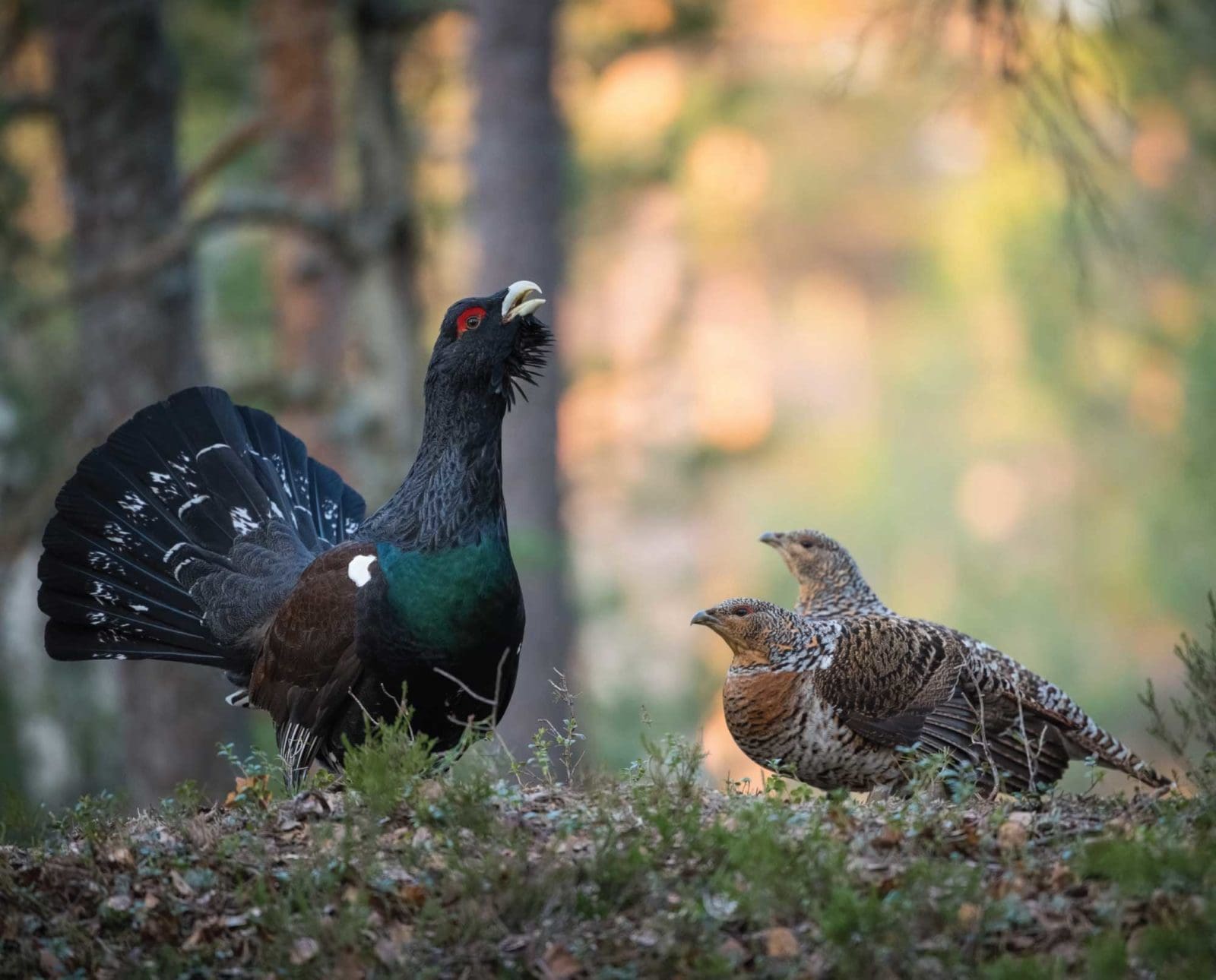
From their home base in Winnipeg, Craig Koshyk and Lisa…
What if more than just a few of the many programs to introduce foreign species of gamebirds to North America had succeeded?
Hunters everywhere train and hunt over their gundogs in a manner that suits the game they pursue and the terrain in which the game is found. In North America, the way we train our dogs and hunt upland birds over them is mainly based on the behavior of native species like the bobwhite quail, ruffed grouse, and North American woodcock. Even when we hunt non-native species like pheasants, huns, and chukar, we tend to use our dogs in more or less the same way. But what if more than just a few of the many programs to introduce foreign species of gamebirds to North America had succeeded? How would we train and hunt over our dogs if, instead of pheasants, huns, and chukar, other foreign game bird species had taken hold in the US and Canada?
Listen to more articles on Apple | Google | Spotify | Audible
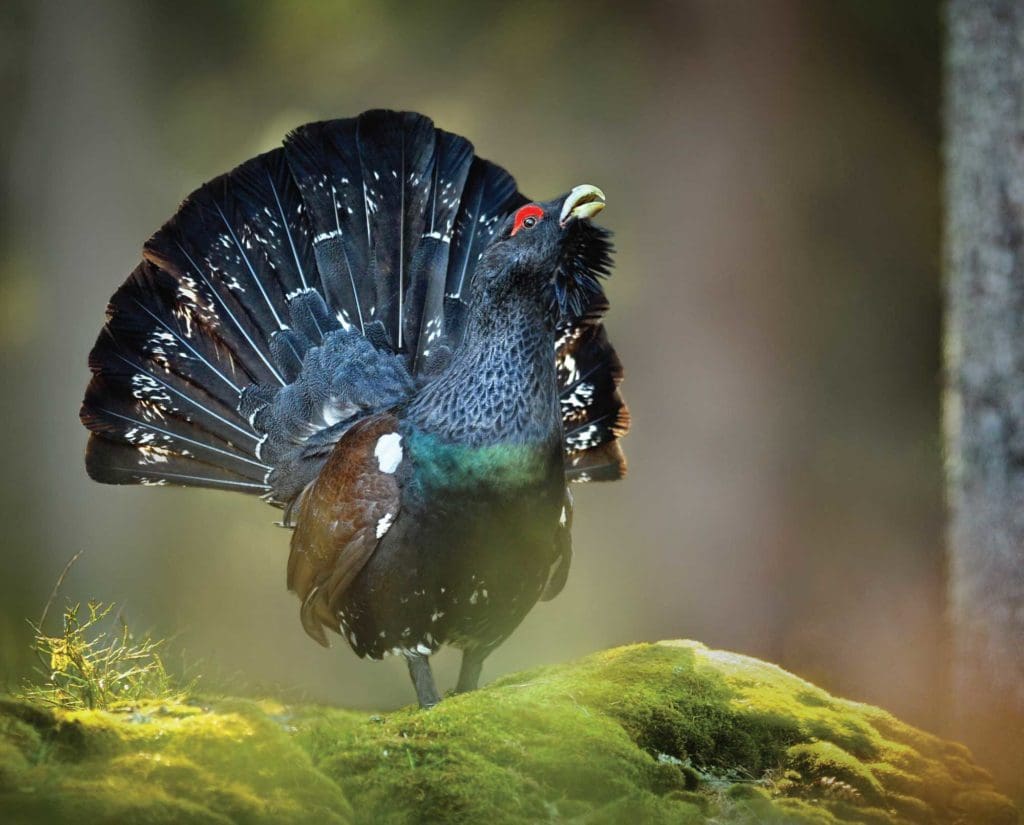
The Western Capercaillie (Tetrao Urogallus)
You’ve been at it all morning and haven’t seen a single bird. It’s cold. There’s a fresh layer of snow on the ground and your dog’s been working his butt off, most of the time completely out of sight. But that’s par for the course this late in the season in northern Maine.
Another half hour goes by. Nothing.
Just as you were about to call it a day, your dog rushes back towards you, excited. You can tell by his wiggling butt and wide eyes that he’s giving you the signal: “I found one, boss, follow me!”
Together, you make your way through the forest, back towards where you first saw him emerge. Creeping along, side by side, you cover 100 yards. Your dog eases into a point just ahead of you. You take a step. Bird up!
A massive black bird explodes from the cover, its 40-inch wingspan creating a noise like a tractor starting up on a cold day. It offers you a crossing shot, left to right at about 25 yards
BANG! Nailed it!
You send your dog to make the retrieve. He delivers to hand. As you hoist the nearly 10-pound bird by the neck, the incredible plumage glistens in the warm light filtering between the spruce trees. It’s your very first capercaillie, Tetrao urogallns, the largest member of the grouse family.
Good boy! Let’s tag the bird and head home.
This is, of course, pure fiction. There are no capercaillie in Maine or anywhere else in North America–but not for a lack of trying. Over the last 250 years, dozens of bird species have been introduced to North America. Only a few managed to thrive. In a fascinating bulletin published by the U.S. Department of Agriculture in 1929, there is an overview of all the then-known efforts to establish breeding populations of game birds in the United States. Here is what the report says about the Capercaillie (spelled capercailzie with a silent ‘z’ at the time, the name comes from the Scottish Gaelic capall-coille meaning “wood-horse”).
What more natural desire among sportsmen than an attempt to introduce to the somber northern forests the capercailzie, a magnificent European game bird second only to the turkey in size and sporting attributes. Were it not for the great expense involved in procuring and shipping these large birds, many more trials would have been made. All the various attempts in widely different regions of the United States and Canada have failed to give evidence that the species has any power of adaptation to new conditions.
As long ago as 1869, Captain Hardy in his book, Forest Life in Acadie, suggested their introduction into the eastern provinces. In 1890, W. W. Thomas, United States minister to Sweden, made up some interest in the subject. The first pair, so far as known to the writer, arrived at Westerly, R. 1., in 1893 for D. F. Stillman. Through Mr. Thomas’s efforts, four were liberated at New Sweden in northern Maine in 1895. In 1904, 143 capercailzie and black game were put out on Grand Island, Mich., by the Cleveland Cliffs Iron Co., and 58 more followed in 1905. It was rumored that four broods of chicks were identified by the gamekeeper, but all individuals disappeared within a year or two.
Previous to this, in 1903, 65 capercailzie, together with some black game, were imported from Denmark or Sweden and placed in Algonquin Park, Ontario, by the provincial authorities, and some of these birds wandered a long distance, so T. S. Palmer states. There were rumors, probably erroneous, of young broods and of some being seen after five years.
In 1906 the total number of capercailzie* and black game imported into this country increased to 235, and most of these went to private preserves in the Adirondacks. A few were placed in Litchfield Park near Big Tupper Lake, but probably not more than a dozen, according to E. Hubert Litchfield. Eighty-five capercailzie, besides some black game, went to William Rockefeller in the Adirondacks at this time, and W.Seward Webb received many for his Adirondack preserve. J. A. Wheeler, game commissioner of Illinois, got four capercailzie and six black game, and Cecil French kept a pair of each in his aviaries.
In the fall of 1907, 23 capercailzie, as well as 20 black game, were shipped from Copenhagen to Newfoundland, via New York, and subsequently transferred to the peninsula of Avalon without loss. The experiment was initiated through the efforts of Sir Robert Bond, and the arrangements were made by John G. Millais, who mentions the plan in his book on Newfoundland (1907). A recent letter from Newfoundland procured through Robert Bartlett tells a little about the fate of these birds. They were released in October midway between Whitbourne and Colinet on the east end of the island. Food was supplied and the birds remained in the neighborhood for several weeks. Some boys disposed of at least two, and the rest soon vanished and were never seen again.
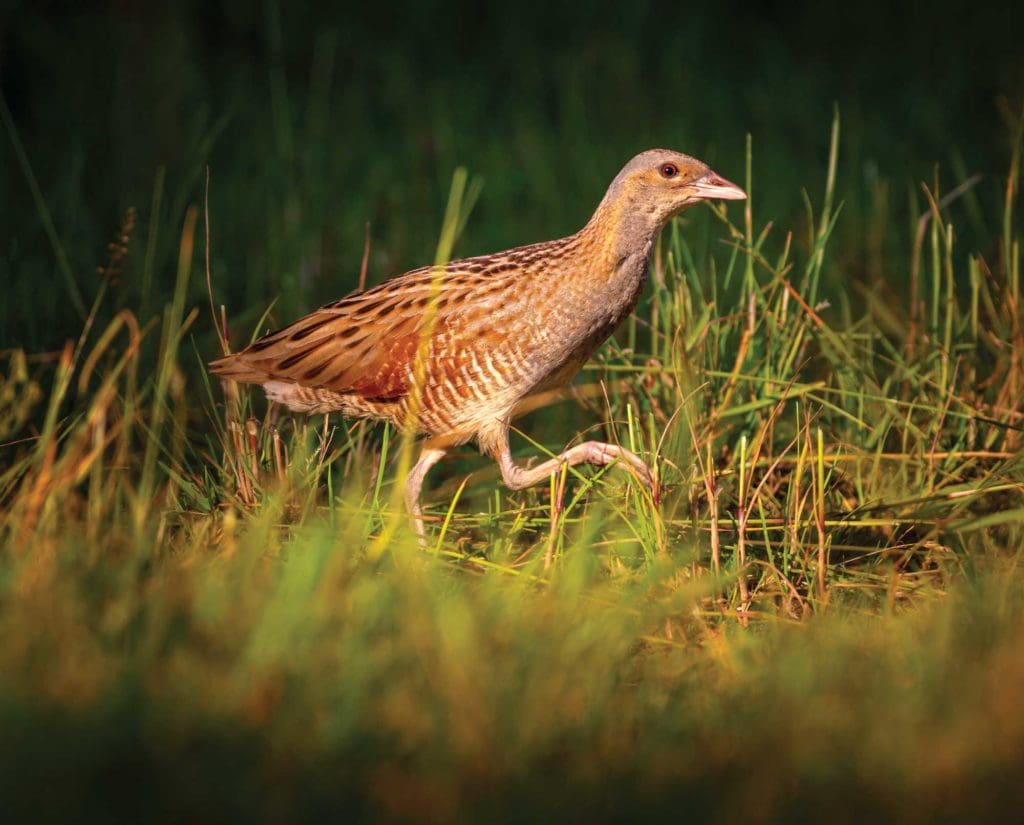
The Corncrakes (Crex crex)
It’s early season, hot enough to hunt in a t-shirt. Too many leaves remain on the trees, so chasing ruffies is out, and the woodcock flight won’t be in for a couple of weeks. Instead, you head to a local pasture that is still soggy from recent rains. You cast your dog into the wind and watch him gallop across the vast acreage.
Point! You hurry to cover the distance, doing your best to avoid puddles and water-filled ruts. Now at your dog’s side you say “easy,” and together you move slowly forward. These birds like to run before taking flight, so you’ve trained your dog to do what the Brits call “drawing,” or carefully stalking a moving bird until it flushes.
Five yards, ten yards, a sharp turn to the right, another ten yards. Flush!
Your first shot is low. Your second connects.
Fetch!
Your dog returns with a medium-sized bird. It has a grey-streaked brownish breast, chestnut markings on the wings, and white and rust-coloured bars on the flanks. It’s a corncrake, a migratory member of the rail family. In the past, corncrakes (Crex crex) were hunted in many parts of Europe, but they are now on the protected species list everywhere except in Russia where hunters still pursue them over pointing dogs.
Some of these little rails apparently were set free by the Cincinnati Acclimatization Society between 1872 and 1874, but how many seems not to be known. There are a number of records of the corncrake taken in this country, 14 up to the year 1914 and others since. It has occurred once in Bermuda, once in Maryland, three times in New Jersey, five times in New York, and once each in Rhode Island, Maine, Nova Scotia, and Newfoundland. These were probably genuine stragglers from the Old World.
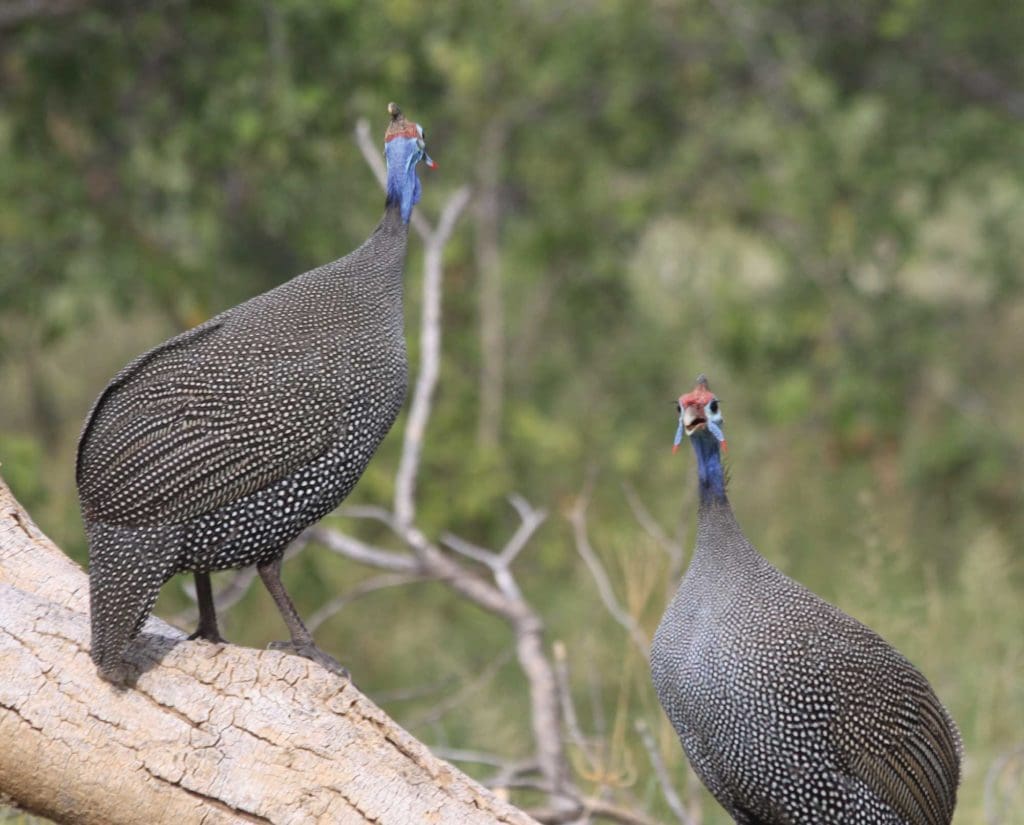
Guinea Fowl (Numida Meleagris)
You shiver in early morning light as you stand along the edge of a forest, your Golden Retriever at your feet. Two of your hunting buddies are to your left, spaced 30 yards apart along the same forest edge. Three more buddies are in the forest a few hundred yards away. They drew the short straws this morning, so they get to do the ‘beating,’ moving slowly through the trees with flushing dogs to force birds into flight and, hopefully, over you.
A bird appears high overhead; it’s too far for a shot, but there’s another right behind it. Then another, and another. Soon there are birds everywhere and you are struggling to reload your gun fast enough. But the practice sessions you spent at the gun range this summer are really paying off and so is the steadiness training you did with your dog. He’s rock-solid, sitting at your side even as you drop bird after bird.
Then, as suddenly as it started, it’s all over. Your friends emerge from the forest and everyone gets together for the “picking up.” Most shots were clean kills, but there are still a few runners to be picked up, and your dog makes it look easy as he tracks down and fetches three birds in short order. You couldn’t be more proud.
Admiring the day’s bag, you and your friends review the action, shot by shot. On the drive back home, you press the button on your iPhone, “Hey Siri, what wine pairs best with roasted Guinea Fowl?”
There was at least one attempt in the United States to make the guinea fowl a game bird. The trial was made with 40 or 50 of them on Jekyl Island, Ga., about 1890, but apparently without permanent results. Nash Buckingham writes of a temporary success in California some 25 years ago.
Guinea fowls have, of course, been domesticated all over the United States, especially in the southern part. and have thus had plenty of opportunity to escape and establish themselves in a feral state. Nevertheless, they have shown absolutely no indication of reverting to the wild, which seems rather surprising in view of the fact that they have done so in some of the islands of the West Indies. They were certainly introduced long ago into most of these islands and are now found in a wild state in Jamaica, Cuba, Porto Rico, Dominican Republic, and a few of the Lesser Antilles. Where that obstreperous animal, the mongoose, is present, it preys extensively on guinea fowl and keeps their numbers much in check. On Barbuda, in the Lesser Antilles, which was made into a sort of game preserve more than 200 years ago, the birds still flourish.
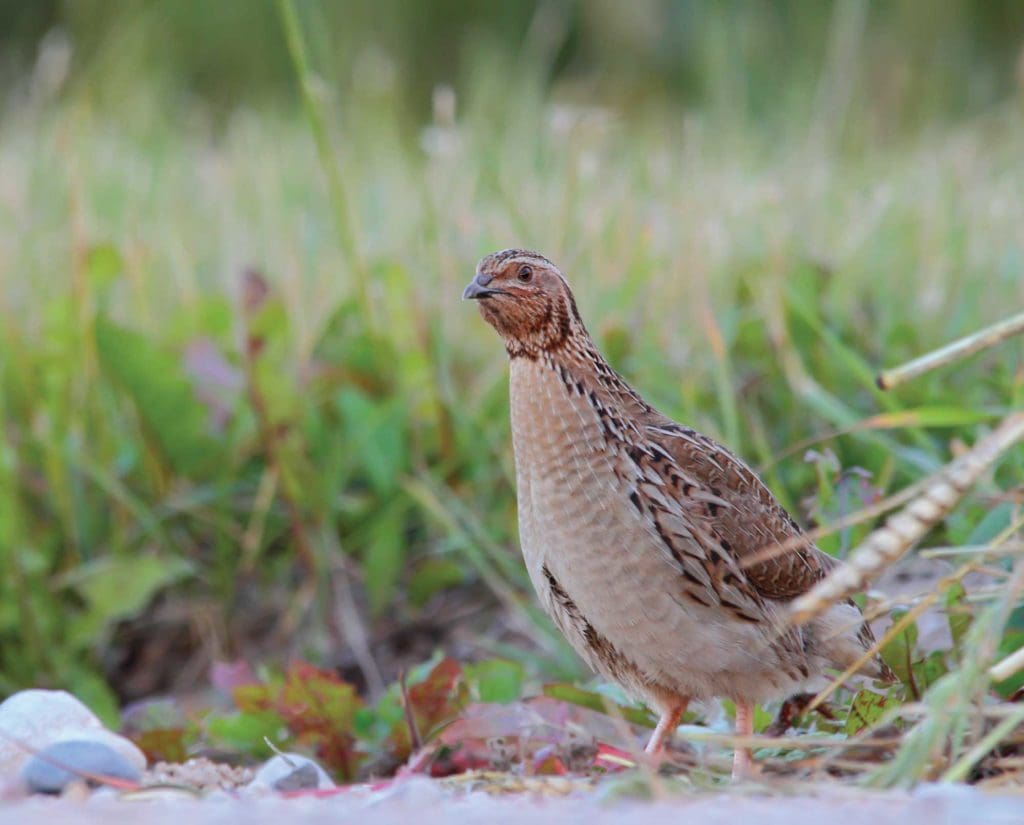
European Quail (Coturnix Coturnix)
Your phone vibrates. It’s a text from your buddy from up north. “Birds are on the move, you should see them in a couple of days.”
“Awesome!” you reply, “I’ve got a new pup, a young Springer. He works close, hunts hard, and seems to have a pretty good nose. I can’t wait to get him onto those quail when they finally make it down here.”
Quail? Coming from the north?
The Common or European quail is a favorite game bird for many European hunters and field trial enthusiasts who usually pursue them with pointing dogs. The only truly migratory galliforme bird, they are found throughout much of Europe in the spring and summer. In the fall, they cross the Mediterranean sea to spend the winter in North Africa.
In the mid-1800s American and Canadian sportsmen invested considerable resources into programs aimed at establishing the species—called the Egyptian Quail at the time—as a game bird in North America. For a while it seemed that success was at hand.
The great excitement among sportsmen over the historic European, or Egyptian quail began about 50 years ago and is now almost entirely forgotten. These little game birds began to be imported into the Eastern States from Sicily and Messina, Italy, in 1875, and large numbers were introduced into Quebec, Ontario, Maine, New Hampshire, Vermont, Massachusetts, New York, New Jersey, Pennsylvania, Virginia, and Ohio. Horace P. Toby, of Boston, was one of the first enthusiasts, and a great deal of information on the subject may still be found in the files of Forest and Stream and other journals in the seventies and eighties.
The history of the first cases is as follows: On March 27, 1875, W. Hapgood, of Boston, wrote to Domonic Fisher, at Messina, Italy: “How can we get European quail for introduction here’?” Fisher replied: “Two cages containing 250 European quail shipped, addressed to John H. Whitcomb, Ayer Junction, Massachusetts.” These were obtained through the good offices of Capt. P. M. Beal of the bark Neptune. Sixty-one died in passage and 189 were distributed in Massachusetts near Ayer. By a curious coincidence M. G. Evart’s birds from a different locality arrived on the same vessel and were liberated near Rutland, Vt. The 200 in this first shipment to Vermont were set free June 8, 1877. These birds were actually found breeding near Rutland, Vt., on July 7, 1877. The total cost of this shipment was said to be 18 lira (about $3) a bird.
It will be sufficient merely to summarize the experiences of many observers with Egyptian quail and to remark that the experiments were carried out on a sufficiently large scale. It is noted that 5,100 arrived May 5, 1880, and were placed in 16 different localities. Most of these birds came in excellent condition. There are many reports of breeding during the first season and also of individual birds that stayed near their point of release until November or even December; but after migration there was never any return movement. One was taken as far south as Georgia and another in North Carolina. Some are said to have come aboard a ship in November, 1877, hundreds of miles southeast of Cape Hatteras, and the theory was prevalent at the time that most of the introduced birds migrated in a southeasterly direction and perished at sea.
Thus ended another chapter of discouragement for the sportsmen of the Atlantic Coast States, who about this period were making desperate efforts to increase their game supply. There seem to have been no shipments after 1881.
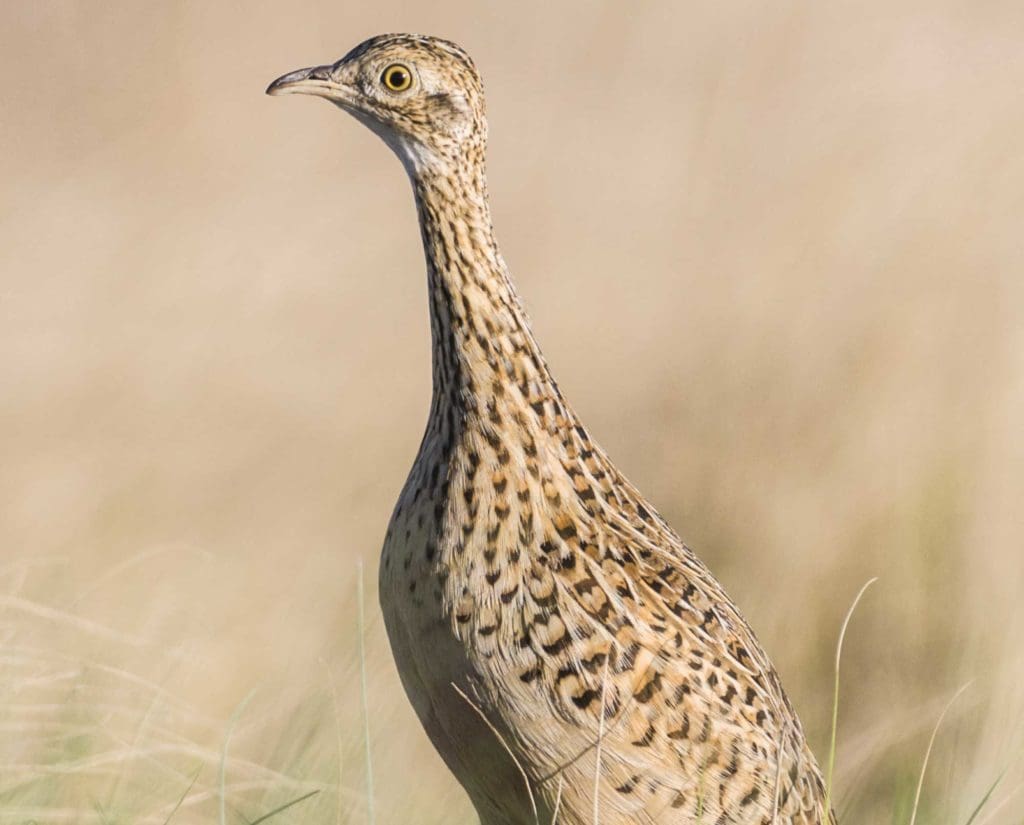
Perdiz (Nothura Maculosa)
“Saddle up!”
“Okay, grab the line.”
“Got it.”
You’re on horseback and so is your buddy. You spread out, about 75 yards apart, each holding one end of a long rope that you drag across the grass of a large section of CRP. About ten yards behind the rope, three friends carrying shotguns walk with their Labs at heel. As your group moves across the field, birds flush, forced into the air by the line. As they rise, the shooters take aim and drop one, then two, then three. The Labs are sent to retrieve.
Normally you hunt these birds with your German Shorthaired Pointer and your buddy’s French Brittany because they usually hold well for points. But today you decided to invite some friends to hunt perdiz like your grandpa did back home in Argentina, on horseback with a dragline.
In less than an hour, your party has limited out. Six perdiz per gun. The dogs were well-behaved and the young pup even managed to catch a cripple that tried to get away in the long grass. As you place the birds on the tailgate to take a photo, you stop to appreciate these birds, Nothura maculosa, a species of tinamou native to parts of South America.
In the early 1920s there was an attempt to import some tinamous from Argentina where they are very popular among hunters, but it was unsuccessful. In 1969 a study of the spotted tinamous conducted by Gardiner Janet Bump was published by the Bureau of Sport Fisheries and Wildlife. The authors wrote:
In search of foreign game birds particularly adaptable to such habitat types, biologists of the Bureau’s Foreign Game Investigation Program spent almost 3 years in a substantial study of tinamous, a group of birds well adapted to the pampas, savannahs, and grassy brushlands of Argentina. A major objective of the investigation of tinamous in Argentina was the location and study of game birds potentially adaptable to grasslands, including grazed pastures, in the United States.
These birds, while not large, provide enough excellent meat to justify the price of a shell, particularly if the bird can be shot along the road or on the ground. Thus there is little excuse for trapping them except for sale which is now illegal. There are also many experienced hunters to which the bird on the wing or with evasive tactics offers a challenge within their ability to meet. It may hide and must be found. It may run and be forced to fly. It may provide a nice, straight away shot. Some sit well to a dog, others sneak away only to fly suddenly from an unexpected spot. Finally, almost anywhere in grasslands one can flush at least 5 to 10 birds in an hour. Only those deeply in love with a special species, such as waterfowl, can ask for better recreation. Most spotted tinamous are hunted by two to four sportsmen walking in a line through the fields. For special occasions there are well organized hunts in which the birds are flushed by a rope or cable, often 150 to 250 feet in length, pulled over the vegetation by two horses. The men follow the rope closely with boys by their sides to pick up shot birds and run down those wounded, often with the aid of a man or two on horseback. On one such hunt, we flushed 484 spotted tinamous from 264 acres of pasture in about 42 hours using a cable 275 feet in length. A strip about 250 feet in width was thus covered, allowing for the sag of the cable. On this hunt 9 shooters collected 256 birds. This represented 53 percent of the birds flushed. This shoot, the only hunting permitted, is an annual affair and has now been conducted over a period of about five years with consistently large numbers of birds being flushed each year. Certainly the most enjoyable way to hunt these tinamous is with a well-trained bird dog.
Despite the findings and recommendations of experts, all efforts to establish tinamou populations in the US failed. Today, if you want to hunt perdiz, you’ll need to head to Argentina.
Other Failed Game Bird Introductions in North America
What if the program had been a success? Would North American upland hunters take to capercaillie hunting like they’ve taken to hunting imported birds like pheasants, huns, and chukars? And would they have trained their dogs to perform the act of ‘reporting’ described above like some hunters in Finland, Russia, and elsewhere do? Would there be field trials or sections of NAVHDA tests that tested dogs to do it?
There is no official tally of the number of attempts made to introduce other species of game birds but the bulletin reveals that failures far outnumber the successes. Only ring-necked pheasants, huns, and chukars succeeded where so many others failed.
The early history of the introduction of foreign birds into this country is mostly clothed in darkness. The records of many attempts, if such there were, have long since been buried in back numbers of local newspapers, and if any experiment was unsuccessful it was soon forgotten. Hence, one trying to get an accurate idea of what has happened soon realizes that he is following a hopeless quest. It is much the same with the transplanting of native birds, especially game birds, which have been carried about all over the country from west to east and from east to west without much regard to the failures of still earlier attempts. Consequently the comparatively recent files of sportsmen’s periodicals and the memory of men still living must be depended upon for most of this history, and such sources are often inaccurate; even the correct name of the species may be in doubt.
Search through local newspapers might add to the slender stock of knowledge, but the results would be wholly disproportionate to the labor involved. In spite of this, it is thought worthwhile to call attention to a great number of real biological experiments that have been going on, unrecorded and almost unknown to the ornithologist.
If one could look back through some of the account books of the early Virginia colonists, it is likely that he might find mention of imported pheasants or European partridges, for the planters of the early seventeenth century were keen sportsmen and, of course, familiar with English game birds. It is known positively from George Washington’s journal that Lafayette in 1786 sent pheasants of several species as well as French partridges to Mount Vernon, although it is not known whether any attempt was made to propagate them. In New Jersey there were early introductions (1790) of game birds on the estate of Richard Bache, a son-in-law of Benjamin Franklin, near what is now Beverly. There is no evidence of any spread from these early trials.
Periods of activity in acclimatization began late in the sixties, and from that time forward something is known about what was attempted. There were, for instance, 15 or 20 years during which efforts were made to introduce European songbirds, largely through the enthusiasm of German-American bird fanciers and various cage-bird clubs. Then came a time when the Eastern States, their home stock already much depleted, turned to the West for new game birds and to the Middle Atlantic States for bobwhites. Indeed, it is believed that this last-mentioned activity had been going on in a quiet way by private effort for a long time, doubtless considerably before the Civil War, but the birds were planted secretly, with the hope of evading the ever-present market gunner.
Except for the craze over the little migratory Egyptian quail late in the seventies, not much attention was paid to foreign game birds until after the successful introduction of pheasants in Oregon in 1881. After this became known in the East the country went wild over pheasants, variously called Mongolian, Chinese ring-necked, and English, without much regard to the actual stock. The nineties saw this species more or less established in many parts of the Northeastern States. The so-called Hungarian partridge (Perdix) came next and that chapter is not yet concluded. Although great shipments were made just before the World War they have not been repeated.
In this bulletin, which is little more than an attempt to gather some of the scattered information that exists in out-of-the-way places, the writer has tried to call attention to all species that have been brought to this country with the object of adding to our list of birds, besides our American game birds, particularly the bobwhite and the California quail, which have been carried to every corner of the land, often into territory hopelessly unsuited to them. The failures, where they are known, have been considered as well worth recording, in the hope that a knowledge of them will lead to more rational selection of experimental material in the future.
The “What If” of North American Non-Native Game Birds
What if there were no pheasants in the Dakotas, but plenty of capercaillie in the Northeast? Would we train our dogs to “report” and then prove their abilities at hunt tests? What if there were no bobwhites, but European quail instead? Would upland hunters await their arrival as eagerly as they wait for the woodcock flight? Would we run field trials on them? And what if there were no huns, but we had open seasons for corncrakes and guinea fowl? Would we hunt flooded fields or organize driven hunts?
The game birds described above are just a few among the dozens of species North American sportsmen attempted to introduce to the continent. It is highly unlikely that other species will ever be introduced to our hunting fields and forests in the future, at least deliberately. But maybe we could adapt some of the techniques used to hunt birds in other regions to our own native birds. Reporting might be a great way to hunt spruce grouse or maybe even turkey. As for drawing in the English way, I can say from personal experience that it is very useful for hunting early season sharptail grouse. In fact, I now train all my dogs to do it. And how about using a dragline suspended between two mounted riders for pheasants? How would we modify the training of our Labs or Springers to work that sort of hunt?
Hunters everywhere train and hunt over their gundogs to suit the game they pursue and the terrain in which the game is found. Change one or the other, or both, and you’d have to change the way you train and hunt.
From their home base in Winnipeg, Craig Koshyk and Lisa Trottier travel all over hunting everything from snipe, woodcock to grouse, geese and pheasants. In the 1990s they began a quest to research, photograph, and hunt over all of the pointing breeds from continental Europe and published Pointing Dogs, Volume One: The Continentals. The follow-up to the first volume, Pointing Dogs, Volume Two, the British and Irish Breeds, is slated for release in 2020.




One species that missed mention in this article that has managed to establish itself is the Himalayan Snowcock in the Ruby Mountains of Nevada
it would be nice to have European woodcock here. i dont know if they migrate though ?
Hello Craig
Thank you for this article.
From memory 20+ years distant, Oregon Fish and Game attempted introduction of European Red Legged Partridge into both coastal Oregon and into its eastern edge, perhaps Malheur County, home to populations of its cousin Alectoris graeca. I haven’t heard anything of the success or failure of this introduction.
Here in SW Idaho, there is a remnant population of Bobwhite quail, transplanted (I believe) somewhere between 1930-1950.
Your article mentioned “reporting” pointing dogs. Years ago, I rough shot red grouse in the UK over “reporting pointers “(GSP) and was duly impressed. I recall that the breeder claimed that the reporting trait was genetic with incomplete penetrance. If you have further thoughts, would appreciate hearing.
Thank you and good luck afield.
Stephen